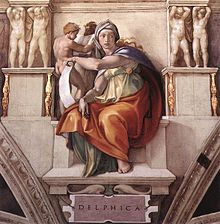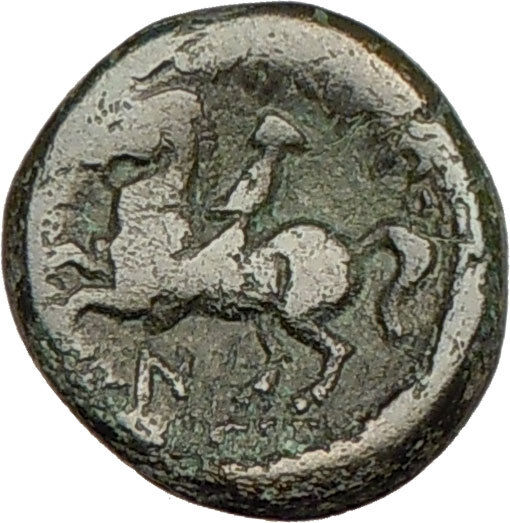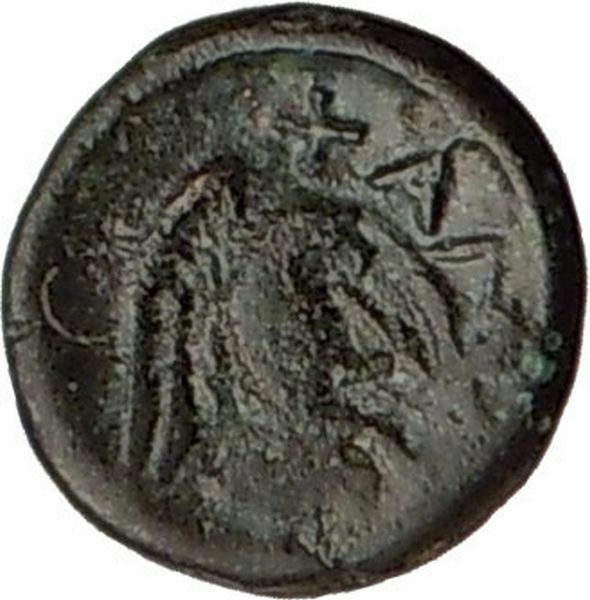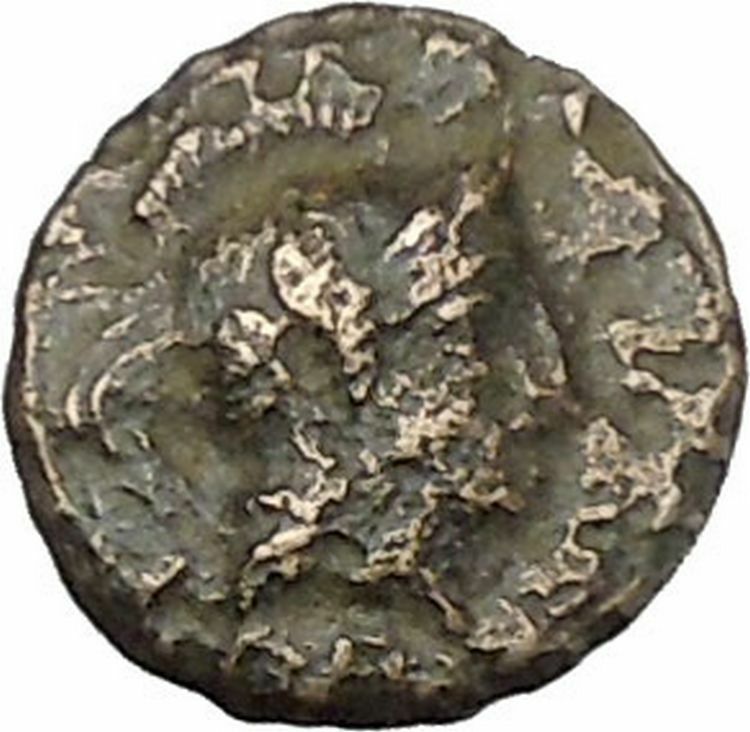|
Greek city of
Gergis
in
Troas
Bronze 11mm (1.71 grams) Struck circa 400-241 B.C.
Reference: Sear 4098; SNG Copenhagen 337; SNG vA 1513
Facing head of
Sibyl Herophile
, turned slightly right, wearing laurel wreath.
ΓEP before
Sphinx
seated right.
The Sibyl played an important role in antiquity. The first recorded use of the
name Sibyl was in the fifth century BC. Originally Sibyl was the name given to a
single prophetic woman. However the name became generic, and Sibyl was used to
identify a woman who could prophesize. The Sibyls were most commonly associated
with Apollo, who provided them with divine insight into the future. They were
highly revered, and there work was accumulated in a corpus called the Sibyline
books. This collection was housed in the Capitoline Temple of Jupiter., where
they could only be consulted by the senate. The interest in sibyls throughout
the Mediterranean world most likely stemmed from their close connection with
Rome and the Sibyline corpus. The Sibyl Herophile was one of the ten Sibyls
commonly known. She was a daughter of a nymph and a mortal. Herophile was meant
to have been born near Gergis, at Marpessus, and her tomb was in the temple of
Apollo at Gergis. Gergis was one of the three cities known to commemorate Sibyls
on their coins. Her appearance on coins from Gergis would be a way of paying
tribute to Herophile as well as indicating the important location of Gergis in
terms of its proximity to the resting place of divine Sibyl. Herophile was said to have predicted the
fall of Troy. She gave her prophecies in verse, and she delivered them
standing on a stone which she always carried with her.
You are bidding on the exact item pictured,
provided with a Certificate of Authenticity and Lifetime Guarantee of
Authenticity.
The word Sibyl (in
English
,
/
əlsɪbˈ/)
comes (via Latin
) from the
Greek
word σίβυλλα sibylla, meaning
prophetess
. The earliest oracular seeresses
known as the sibyls of antiquity, “who admittedly are known only through
legend”prophesied at certain holy sites, under the divine influence of a deity,
originally— at Delphi
and
Pessinos
— one of the
chthonic
deities. Later in antiquity, sibyls
wandered from place to place.
History
Homer
seems to have been unaware of a Sibyl.
The first known Greek writer to mention a sibyl is
Heraclitus
, in the 5th century BC:
The Sibyl, with frenzied mouth uttering things not to be laughed at,
unadorned and unperfumed, yet reaches to a thousand years with her voice by
aid of the god.’
Walter Burkert
observes that “Frenzied women
from whose lips the god speaks” are recorded very much earlier in the Near East,
as in Mari
in the second millennium and in Assyria in
the first millennium”.
Until the literary elaborations of Roman writers, sibyls were not identified
by a personal name, but by names that refer to the location of their
temenos
, or shrine.
In
Pausanias
,
Description of Greece
, the first Sibyl at
Delphi mentioned (“the former” [earlier]) was of great antiquity, and was
thought, according to Pausanias, to have been given the name “sibyl” by the
Libyans.Sir
James Frazer
calls the text defective. The
second Sibyl referred to by Pausanias, and named “Herophile”, seems to have been
based ultimately in
Samos
, but visited other shrines, at
Clarus
.
Delos
and
Delphi
and sang there, but that at the same
time, Delphi had its own sibyl.
James Frazer
writes, in his translation and
commentary on Pausanias, that only two of the Greek Sibyls were historical:
Herophile of Erythrae
, who is thought to have
lived in the 8th century BC, and
Phyto of Samos
who lived somewhat later. He
observes that the Greeks at first seemed to have known only one Sibyl, and
instances
Heraclides Ponticus
[6]
as the first ancient writer to distinguish several Sibyls: Heraclitus names at
least three Sibyls, the
Phrygian
, the
Erythraean
, and the
Hellespontine
. The scholar David S. Potter
writes, “In the late fifth century BC it does appear that ‘Sibylla’ was the name
given to a single inspired prophetess”.[8]
Number of Sibyls
Like Heraclitus, Plato
speaks of only one Sibyl, but in course
of time the number increased to nine, with a tenth, the
Tiburtine Sibyl
, probably
Etruscan
in origin, added by the Romans.
According to
Lactantius
‘ Divine Institutions (i.6,
4th century AD, quoting from a lost work of
Varro
, 1st century BC) these ten sibyls were
those in the following list. Of them, the three most famous sibyls throughout
their long career were the Delphic, the Erythraean and the Cumaean. Not all the
following Sibyls were securely identified with an oracular shrine, and in the
vague and shifting Christian picture there is some overlap.
Persian Sibyl
The Persian Sibyl was said to be prophetic priestess presiding over the
Apollonian
Oracle
; though her location remained vague
enough so that she might be called the “Babylonian Sibyl”, the
Persian
Sibyl is said to have foretold the
exploits of
Alexander the Great
.[citation
needed] The Persian Sibyl, by name Sambethe,
was reported to be of the family of
Noah.[9]
The 2nd-century AD traveller
Pausanias
, pausing at
Delphi
to enumerate four sibyls, mentions the
“Palestinian Sibyl” who was:
“brought up in Palestine named Sabbe, whose father was Berosus and her
mother Erymanthe. Some say she was a Babylonian, while others call her an
Egyptian Sibyl.”[10][11][12]
The medieval Byzantine encyclopedia, the
Suda, credits the Hebrew Sibyl as author of the
Sibylline oracles
.
Libyan Sibyl

Michelangelo
‘s Libyan Sibyl,
Sistine Chapel
Main article:
Libyan Sibyl
The so-called Libyan Sibyl was identified with prophetic priestess presiding
over the ancient Zeus
Amon (Zeus represented with the horns of Amon)
oracle
at the
Siwa Oasis
in the Western Desert of
Egypt
(incorrectly placed in the map). The
oracle here was consulted by Alexander after his conquest of Egypt. The mother
of the Libyan Sibyl was
Lamia
, meaning “devourer”.
Euripides
mentions the Libyan Sibyl in the
prologue to his tragedy Lamia.
Delphic Sibyl

Michelangelo
‘s Delphic Sibyl,
Sistine Chapel
Main article:
Delphic Sibyl
The Delphic Sibyl was a legendary figure who gave prophecies in the sacred
precinct of Apollo
at
Delphi
, located on the slopes of
Mount Parnassus
. Pausanias claimed that the
Sibyl was “born between man and goddess, daughter of sea monsters and an
immortal nymph
“. Others said she was sister or daughter
to Apollo
. Still others claimed the Sibyl received
her powers from Gaia originally, who passed the oracle to
Themis
, who passed it to
Phoebe
. The Delphic Sibyl has sometimes been
confused with the Pythia
, the priestess of Apollo who gave
prophecies at the Delphic Oracle.[13]
The two are not identical, and should be treated as separate figures.[14]
Cimmerian Sibyl
Naevius
names the Cimmerian Sibyl in his books
of the
Punic War
and
Piso in his annals.
The Sibyl’s son Evander founded in
Rome the shrine of
Pan
which is called the
Lupercal
.
Erythraean Sibyl
The Erythraean Sibyl was sited at
Erythrae
, a town in
Ionia
opposite
Chios
.
Apollodorus of Erythrae
affirms the Erythraean
Sibyl to have been his own countrywoman and to have predicted the
Trojan War
and prophesised to the Greeks who
were moving against Ilium
both that Troy would be destroyed and
that Homer
would write falsehoods.
The word acrostic was first applied to the prophecies of the
Erythraean Sibyl, which were written on leaves and arranged so that the initial
letters of the leaves always formed a word.
Samian Sibyl
The Samian sibyl’s oracular site was at
Samos
.
Cumaean Sibyl
The sibyl who most concerned the Romans was the
Cumaean Sibyl
, located near the Greek city of
Naples
, whom
Virgil
‘s Aeneas consults before his descent to
the lower world (Aeneid
book VI: 10). Burkert notes (1985, p 117) that the conquest of Cumae by the
Oscans
in the 5th century destroyed the
tradition, but provides a terminus ante quem for a Cumaean sibyl. It was
she who supposedly sold to
Tarquinius Superbus
, the last king of Rome, the
original
Sibylline books
(q.v.). Christians were
especially impressed with the Cumaean Sibyl, for in Virgil’s Fourth
Eclogue
she foretells the coming of a savior –
possibly a flattering reference to the poet’s patron – whom Christians
identified as Jesus.[15][16][17]
Hellespontine Sibyl
The Hellespontine, or Trojan Sibyl presided over the
Apollonian
oracle
at
Dardania
.
The Hellespontian Sibyl was born in the village of
Marpessus
near the small town of
Gergitha
, during the lifetimes of
Solon
and
Cyrus the Great
. Marpessus, according to
Heraclides of Pontus
, was formerly within the
boundaries of the Troad
. The
sibylline collection
at
Gergis
was attributed to the Hellespontine
Sibyl and was preserved in the temple of Apollo at Gergis. Thence it passed to
Erythrae
, where it became famous.
Phrygian Sibyl
The Phrygian Sibyl appears to be a doublet of the Hellespontine Sibyl.
Tiburtine Sibyl
To the classical sibyls of the Greeks, the Romans added a tenth, the
Tiburtine Sibyl, whose seat was the ancient
Sabino
–Latin
town of
Tibur
(modern
Tivoli
). The mythic meeting of
Augustus
with the Sibyl, of whom he inquired
whether he should be worshiped as a god, was a favored
motif
of Christian artists. Whether the sibyl
in question was the
Etruscan Sibyl
of Tibur or the
Greek Sibyl
of
Cumae
is not always clear. The Christian author
Lactantius
had no hesitation in identifying the
sibyl in question as the Tiburtine sibyl, nevertheless. He gave a circumstantial
account of the pagan sibyls that is useful mostly as a guide to their
identifications, as seen by 4th century Christians:
The Tiburtine Sibyl, by name Albunea, is worshiped at Tibur as a
goddess, near the banks of the
Anio
, in which stream her image is said to
have been found, holding a book in her hand. Her
oracular
responses the Senate transferred
into the capitol. (Divine Institutes I.vi)
An apocalyptic pseudo-prophecy exists, attributed to the Tiburtine Sibyl,
written c. 380 CE, but with revisions and interpolations added at later dates.[18]
It purports to prophesy the advent of a final Emperor named Constans,
vanquishing the foes of Christianity, bringing about a period of great wealth
and peace, ending paganism and converting the Jews. After vanquishing
Gog and Magog
, the Emperor is said to resign
his crown to God. This would give way to the
Antichrist
. Ippolito d’Este rebuilt the
Villa d’Este
at Tibur, the modern
Tivoli
, from 1550 onward, and commissioned
elaborate fresco murals in the Villa that celebrate the Tiburtine Sibyl, as
prophesying the birth of Christ to the classical world.
Later Sibyls
The medieval, Christianized role for these augmented Sibyls was as
precursors, prophets of the New Dispensation, Christian allies in a Hellenistic
world:
- Dies irae
, dies illa
- Solvet saeclum in favilla
- Teste David cum Sibylla.
- (“Day of wrath, that day / will loose the age in ash / by the
witness David with the Sibyl.”)
In the Middle Ages the number of Sibyls was canonized as twelve, a
symbolic number
. See, for example, the
Apennine Sibyl
, though sometimes, e.g. for
François Rabelais
, ten was still the proverbial
number: “How know we but that she may be an eleventh Sibyl or a second
Cassandra?”
Gargantua and Pantagruel
, iii. 16, noted in
Brewer’s Dictionary of Phrase and Fable, 1897.[19]
Late
Gothic
Sibyls, each with her emblem and a
single line of prophecy, lettered on a fluttering
banderole
, were fixtures of Late Gothic
illuminations, in 14th and 15th-century France and Germany.[20]
From the early Renaissance, the Sibyls were also represented in publicly
available art.
Michelangelo
fixed our image of the sibyls
forever, in his powerful representations of them, seated, both aged and ageless,
beyond mere femininity, in the frescos of the
Sistine Chapel
. Five sibyls were painted on the
Sistine Chapel ceiling
by
Michelangelo
; the Delphic Sibyl, Libyan Sibyl,
Persian Sibyl, Cumaean Sibyl and the Erythraean Sibyl. The library of
Pope Julius II
in the
Vatican
has images of sibyls and they are in
the pavement of the
Siena
Cathedral. The Basilica of
Santa Maria in Aracoeli
crowning the
Campidoglio
, Rome, is particularly associated
with the Sibyl, because a medieval tradition referred the origin of its name to
an otherwise unattested altar, ARA PRIMOGENITI DEI said to have
been raised to the “firstborn of God” by the emperor Augustus, who had been
warned of his advent by the sibylline books: in the church the figures of
Augustus and of the Tiburtine sibyl are painted on either side of the arch above
the high altar. In the 19th century
Rodolfo Lanciani
recalled that at Christmas
time the
presepio
included a carved and painted
figure of the sibyl pointing out to Augustus the Virgin and Child, who appeared
in the sky in a halo of light. “The two figures, carved in wood, have now [1896]
disappeared; they were given away or sold thirty years ago, when a new set of
images was offered to the Presepio by prince Alexander Torlonia.” (Lanciani,
1896 ch 1) Like prophets, Renaissance sibyls forecasting the advent of Christ
appear in monuments: modelled by
Giacomo della Porta
in the Santa Casa at
Loreto
, painted by Raphael in
Santa Maria della Pace
, by Pinturicchio in the
Borgia apartments
of the Vatican, engraved by
Baccio Baldini, a contemporary of Botticelli, and graffites by Matteo di
Giovanni in the pavement of the Duomo of Siena.
The 19th century French historian
Jules Michelet
attributed the origins of
European witchcraft
to the religion of the
sibyls. In his introduction to La Sorcière (1862), Michelet wrote:
A powerful, tenacious religion, as Greek paganism was, begins with the
sibyl, ends with the witch. The former, a beautiful virgin, in the full
light of day, rocked its cradle, gave it its charm and glory. Later, fallen,
ill, in the darkness of the Middle Ages, on heaths and in forests, it was
hidden by the witch…[21]
A sphinx is a
mythical creature
with, as a minimum, the body of a
lion and the head of a human or a cat.
In Greek tradition, it has the haunches of a lion, the wings of a great bird,
and the face of a woman. She is mythicised as treacherous and merciless. Those
who cannot answer her riddle suffer a fate typical in such mythological stories,
as they are killed and eaten by this ravenous monster.[1]
Unlike the Greek sphinx which was a woman, the Egyptian sphinx is typically
shown as a man (an androsphinx). In addition, the Egyptian sphinx was
viewed as benevolent in contrast to the malevolent Greek version and was thought
of as a guardian often flanking the entrances to temples.

In
European decorative art, the sphinx enjoyed a major revival during the
Renaissance
. Later, the sphinx image, something
very similar to the original Ancient Egyptian concept, was exported into many
other cultures, albeit often interpreted quite differently due to translations
of descriptions of the originals and the evolution of the concept in relation to
other cultural traditions.
Generally the role of sphinxes is associated with architectural structures
such as royal tombs or religious temples. The oldest known sphinx was found near
Gobekli Tepe
at another site, Nevali Çori,[2]
or possibly 120 miles to the east at Kortik Tepe,
Turkey
and was dated to 9,500 BC.
Egyptian sphinxes
The sphinx is located in the north and below the pyramids. What names their
builders gave to these
statues
is not known. At the Great Sphinx site,
the inscription on a stele
by
Thutmose IV
in
1400 BCE
, lists the names of three aspects of
the local sun deity of that period,
Khepera
–Rê–Atum.
The inclusion of these figures in tomb and
temple
complexes quickly became traditional and
many pharaohs had their heads carved atop the guardian statues for their tombs
to show their close relationship with the powerful solar deity,
Sekhmet
, a lioness. Other famous Egyptian
sphinxes include one bearing the head of the pharaoh
Hatshepsut
, with her likeness carved in
granite
, which is now in the
Metropolitan Museum of Art
in New York, and the
alabaster
sphinx of Memphis
,
Memphis, Egypt
, currently located within the
open-air museum at that site. The theme was expanded to form great
avenues
of guardian sphinxes lining the
approaches to tombs and temples as well as serving as details atop the posts of
flights of stairs to very grand complexes. Nine hundred with ram heads,
representing Amon
, were built in
Thebes
, where his cult was strongest.
Perhaps the first sphinx in Egypt was one depicting
Queen Hetepheres II
, of the
fourth dynasty
that lasted from
2723
to
2563 BC
. She was one of the longest-lived
members of the royal family of that dynasty.
The largest and most famous is the
Great Sphinx of Giza
, sited at the
Giza Plateau on the west bank of the
Nile River
and facing due east (29°58′31″N
31°08′15″E).
It is also from the same dynasty. Although the date of its construction is
uncertain, the head of the Great Sphinx now is believed to be that of the
pharaoh Khafra
.
The Great Sphinx has become an emblem of Egypt, frequently appearing on its
stamps, coins, and official documents.[4]
Greek traditions
From the Bronze Age
, the Hellenes had trade and cultural
contacts with Egypt. Before the time that
Alexander the Great
occupied Egypt, the Greek
name, sphinx, was already applied to these statues. The historians and
geographers of Greece wrote extensively about Egyptian culture. Heredotus called
the ram-headed sphinxes, criosphinges, and the hawk-headed ones,
hieracosphinges
.
The word sphinx comes from the
Greek
Σφίγξ, apparently from the verb σφίγγω (sphíngō),
meaning “to squeeze”, “to tighten up”.[5][6]
This name may be derived from the fact that the hunters for a pride of lions are
the lionesses, and kill their prey by strangulation, biting the throat of prey
and holding them down until they die. The word
sphincter
derives from the same root.
However, the historian Susan Wise Bauer suggests that the word “sphinx” was
instead, a Greek corruption of the Egyptian name “shesepankh,” which meant
“living image,” and referred rather to the statue of the sphinx, which
was carved out of “living rock” (rock that was present at the construction site,
not harvested and brought from another location), than to the beast itself.[7]
There was a single sphinx in Greek mythology, a unique demon of
destruction and bad luck. According to
Hesiod
, she was a daughter of
Orthus
[8]
and either
Echidna
or the
Chimera
, or perhaps even
Ceto;[9]
according to others, she was a daughter of Echidna and
Typhon
. All of these are
chthonic
figures from the earliest of Greek
myths, before the Olympians ruled the Greek
pantheon
. The Sphinx is called Phix (Φίξ) by
Hesiod
in line 326 of the
Theogony
, the
proper name
for the Sphinx noted by
Pierre Grimal
‘s The Penguin Dictionary of
Classical Mythology.
In
Greek mythology
, a sphinx is represented as a
monster with a head of a woman, the body of a
lioness, the wings of an
eagle
, and a
serpent
headed tail.
The sphinx was the emblem of the ancient city-state of
Chios
, and appeared on seals and the obverse
side of coins from the 6th century BC until the 3rd century AD.
Athena appears in the middle of the upper-half of the middle of a sarcophagus
found in the middle pyramid of Giza, with two sphinxes at her side.

Assyrian
Lamassu
dated 721 BC Institute
Museum, University of Chicago.
The Riddle of the
Sphinx
The Sphinx is said to have guarded the entrance to the Greek city of Thebes,
and to have asked a riddle of travellers to allow them passage. The exact riddle
asked by the Sphinx was not specified by early tellers of the stories, and was
not standardized as the one given below until late in Greek history.[10]
It was said in late lore that
Hera or Ares
sent the Sphinx from her
Ethiopian
homeland (the Greeks always
remembered the foreign origin of the Sphinx) to
Thebes
in Greece where she asks all passersby
the most famous riddle
in history: “Which creature walks on
four legs in the morning, two legs in the afternoon, and three legs in the
evening?” She strangled and devoured anyone unable to answer.
Oedipus
solved the riddle by answering: Man—who
crawls on all fours as a baby, then walks on two feet as an adult, and then
walks with a cane in old age. By some accounts[11]
(but much more rarely), there was a second riddle: “There are two sisters: one
gives birth to the other and she, in turn, gives birth to the first. Who are the
two sisters?” The answer is “day and night” (both words are feminine in Greek).
Bested at last, the tale continues, the Sphinx then threw herself from her
high rock and died. An alternative version tells that she devoured herself. Thus
Oedipus can be recognized as a “liminal”
or threshold figure, helping effect the transition between the old religious
practices, represented by the death of the Sphinx, and the rise of the new,
Olympian
gods.
In Jean Cocteau
‘s retelling of the Oedipus legend,
The Infernal Machine
, the Sphinx tells
Oedipus the answer to the riddle, to kill herself so that she did not have to
kill anymore, and also to make him love her. He leaves without ever thanking her
for giving him the answer to the riddle. The scene ends when the Sphinx and
Anubis
, who is there to kill the victims who
cannot answer the riddle, ascend back to the heavens.
There are mythic, anthropological, psychoanalytic, and parodic
interpretations of the Riddle of the Sphinx, and of Oedipus’s answer to it.
Numerous riddle books use the Sphinx in their title or illustrations.[12]
The word sibyl probably comes (via
Latin
) from the
Greek
word sibylla, meaning
prophetess
.
The earliest oracular seeresses known as the sibyls of antiquity, “who
admittedly are known only through legend”
prophesied at certain holy sites, under the divine influence of a deity,
originally— at Delphi
and
Pessinos
— one of the
chthonic
earth-goddesses. Later in antiquity, sibyls wandered from place to place.
The oldest collection of written Sibylline Books appears to have been made
about the time of Solon
and Cyrus at
Gergis
on Mount Ida
in the Troad
. The sibyl, who was born near there, at
Marpessus
, and whose tomb was later marked by the temple of Apollo built
upon the archaic site, appears on the coins of Gergis, ca 400–350 BCE.
(cf. Phlegon, quoted in the 5th century geographical dictionary of
Stephanus of Byzantium
, under ‘Gergis’). Other places claimed to have been
her home. The sibylline collection at Gergis was attributed to the
Hellespontine Sibyl
and was preserved in the temple of Apollo at Gergis.
Thence it passed to
Erythrae
,
where it became famous. It was this very collection, it would appear, which
found its way to Cumae
and from Cumae to Rome. Gergis, a city of
Dardania
in the Troad, a settlement of the ancient
Teucri
, and,
consequently, a town of very great antiquity (Herodotus iv: 122). Gergis,
according to Xenophon
, was a place of much strength. It had a temple sacred to
Apollo Gergithius
, and was said to have given birth to the Sibyl, who is
sometimes called
Erythraea
, from Erythrae, a small place on
Mount Ida
(Dionysius
of Halicarnassus i. 55), and at others Gergithia (‘of Gergis’).
|













